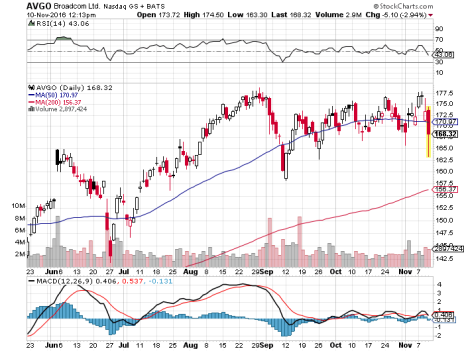Wall Street is notoriously bad at telling investors how to capitalize on big mergers, and it’s happening again with the Broadcom-Brocade merger.
Analysts wait for a company’s post-merger financial results before they’re willing to go out on a limb and say “Buy!” But it can take well over a year from the first announcement of M&A activity to the first combined-company’s quarterly reporting. In the interim, there’s got to be a better way to know whether to buy or sell!
At the beginning of November of 2016, Singapore-based semiconductor company Broadcom Limited (AVGO) announced an agreement to purchase Brocade Communications Systems (BRCD) for $5.5 billion.
[text_ad use_post='135645']
As part of the Broadcom-Brocade merger, Brocade shareholders will receive $12.75 cash per share when the deal closes in the second half of 2017. Based on the current share price of BRCD, there’s only 3-4% upside in the stock between now and the close of the merger, about a year from now. BRCD shareholders should sell their shares, and reinvest in a growth stock that has better capital gain potential. You can quickly acquire an excellent list of undervalued growth stocks by subscribing to Cabot Undervalued Stocks Advisor today!
Brocade is a dominant player in the storage area network business; a business that’s complementary to Broadcom’s offerings of wired infrastructure, wireless communications, enterprise storage and industrial products. Broadcom intends to sell Brocade’s IP networking business, valued at about $2.0-$2.5 billion, in order to avoid competing with its own customers, which include Cisco (CSCO), Intel (INTC), and Hewlett Packard Enterprise (HPE).
The Broadcom-Brocade merger is expected to be promptly accretive to earnings, but won’t necessarily provide big cost synergies, because Brocade is already achieving high margins. The Brocade merger raises Broadcom’s operating margin target from 40% to 45%.
Here’s the recent multi-year progression of M&A activity that led up to Broadcom’s newest acquisition.
· Avago Technologies (AVGO) purchased LSI Corp. (LSI) on May 6, 2014.
· AVGO was added to the S&P 500 index on May 7, 2014.
· Avago Technologies purchased Emulex Corp. (ELX) on May 5, 2015.
- Avago Technologies purchased Broadcom Corporation (BRCM) for $37 billion on February 2, 2016. Avago Technologies changed its name to Broadcom Limited, but retained its stock symbol, AVGO.
Broadcom’s revenue is expected to reach $13.2 billion and $16.3 billion in fiscal 2016 and 2017 (October year-end).
Earnings per share (EPS) were $8.98 in fiscal 2015, and are expected to total $11.25 and $13.45 in 2016 and 2017 (not including the pending BRCD purchase).
When the Avago-Broadcom merger was originally announced in 2015, Wall Street’s consensus earnings estimates projected Avago and Broadcom would each grow EPS by 4-8% per year in 2016 and 2017. Cost synergies from the merger subsequently made a huge impact, with Broadcom’s final full-year 2016 EPS expected to grow 25.3% (October year-end).
Broadcom will report full-year 2016 results on the afternoon of December 8, 2016. Analysts expect another 19.6% EPS growth in fiscal 2017.
Read between the lines: Broadcom is run by smart, strategic, effective people who are capable of optimizing the company’s functions for maximum financial benefit. That wasn’t just one lucky merger. The company combined four large corporations in three years, and effectively accomplished immediate and dramatic profit increases.
The stock’s 2017 price/earnings ratio (P/E) is low vs its EPS growth rate, at 12.9, telling us that the stock is distinctly undervalued.
The current dividend yield is 1.15%. Investors who focus on dividend growth should take note: the company increases its dividend with every quarterly dividend declaration. That’s a highly unusual approach to dividends, but certainly takes the guesswork out of the eternal question, “Will the company increase the dividend?”
The big red flag will be the company’s long-term debt ratio, which has been growing thanks to its steady stream of acquisitions. Broadcom ended fiscal 2015 with a 45% long-term debt-to-capitalization ratio, which will undoubtedly be higher when final 2016 numbers are reported next month, and higher again after the Brocade acquisition.
Broadcom is an undervalued, large-cap aggressive growth stock with steadily rising dividends and a bullish chart. AVGO could appeal to growth investors, value stock investors, and those who focus on stocks with rising dividends.
AVGO rose to an all-time high of $177 in August, and has since traded sideways in an orderly fashion. The trading range recently narrowed toward the top of the range. That’s a bullish chart pattern! Given a neutral-to-bullish stock market, AVGO appears ready to surpass $177 soon and begin a new run-up. I urge investors to buy AVGO today.


